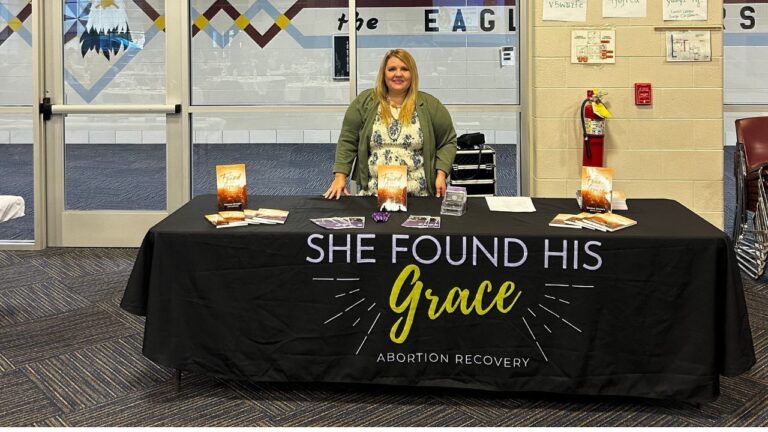Serena Dixen had never even heard the term “abortion” until her parents recommended that she take her at age 13 after being raped and soaked by her uncle.
“One day, I was on a school bus and I was vaguely shaking to someone about what happened to me,” Dyksen told Christian Post in an interview. “I think I was at a point in my life where I needed help.”
Getting pregnant from her uncle in the late 1980s was something Daxen initially tried to hide from embarrassment. However, the guidance counselor later pulled Daxen out of the choir class and asked if the family had attacked her. At first, the child didn’t want to admit that she was assaulted, but in the end she did. The girl’s parents came and took her to her family doctor and referred her to an abortion facility.

Get the latest news for free
Subscribe to get daily/weekly emails with Top Stories (plus special offers!) from Christian Post. I know first.
Dixen’s parents then took her to the Women’s Pavilion Center in South Bend, Indiana. It is one of several facilities run by Ulrich George Croffer after he passed away in September 2019 and was hit by Will County, Illinois, authorities with the discovery of more than 2,000 fetal bodies in his home. The subsequent wreckage was later discovered in the trunk of an abortionist’s car.
Fast forward to today, Daxen uses her experience as a rape victim who bleed after the adults in her life persuaded her to experience a childhood abortion that led other women who found healing and forgiveness in life through the ministry she founded, she found his bounty.
“I bleed everywhere.”

Looking back on her abortion experience, Dyxen recalled that staff at the Women’s Pavilion Centre separated her from her parents during an abortion.
At the time, Daxen thought she and her family were in the clinic.
“And I didn’t know how they would help, so when they asked if I was ready for an abortion, I just nodded my head,” Daxen explained.
When Klopfer came to the room to perform an abortion, Daxen looked at her and said, “This won’t take long.” Later, when Dyksen began screaming during an abortion due to pain, she said Klopfer told her to shut up.
From another room in the facility, Daxen’s mother was able to hear her daughter scream. According to Daxen, when she tried to help her daughter, staff called police and forced her mother to leave the clinic.
After the abortion, Daxen was placed in the recovery room with the other women, but no one saw each other. The room was filled with what Daxen described as “a nasty brown vinyl recliner.”
“When I stood up, I bleed everywhere and my dad took me out,” she recalled. “No one came to check on me, there was no follow-up care.
The abortion experience will continue to bother Daxen and her family for years to come.
“We were already like dysfunctional, you know, a lot of broken,” the department founder said. “This completely rigged it. My mother checked herself in the mental ward, and my father eventually left our family.”
At the age of 16, Dyxen became pregnant again. This time I’m going to have my boyfriend, Blues. Together they went to Elkhart’s planned parent-child relationship and learned about the organization after a representative visited the school to teach sex education.
The pair didn’t know much about Planned Parenthood. They thought it was just one of many potential resources.
“So we went to (Planned Parenthood) and said, ‘You’re young, you’re in school, you’re poor. You should abort your baby,'” she said.
After his appointment, Daxen sat in the car park with Bruce. Bruce was raised in a religious home, but the church he attended did not talk about abortion. While the couple discusses what to do next, Daxen decides to tell Bruce about his 13-year-old abortion.
“And he said, ‘I don’t know how we understand it, but we’ll get it,” she recalled. “And we chose the life of the day.”
Today, Daxen and her husband have been married for over 30 years, but the enduring trauma from Daxen’s abortion has almost destroyed the marriage. She also suffered from a miscarriage at the age of 23, awakening some of her unresolved pain.
“And still, I didn’t connect the point of having double grief due to the abortion,” she explained. “I eventually had an ovarian rupture and I almost bleed and died. And by 29 years, I had to undergo a complete hysterectomy.”
Daxen turned to drugs and alcohol to numb the pain. As for Bruce, Daxen knew he could see himself hurt, but he didn’t know how to solve the problem.
The couple sought counseling and gradually God restored their marriage. During her appointment for counseling, Daxen was opened up about the trauma that stemmed from her rape, not her abortion.
“Now is the time to tell the rest of your story.”
In 2019, a friend invited Dyxen to watch the film Undinned, telling the story of Abby Johnson, former director of the Planned Parenthood Clinic, leaving the abortion industry and becoming a life support advocate. The film resonated with Daxen, who could relate to the sadness Johnson felt after her two abortions.
“I heard the Lord say, ‘Now is the time to tell the rest of your story.’ “I said to the main, ‘I will do whatever you ask me, but please don’t ask me to be the speaker.” I really thought I was going to an abortion clinic and trying to help women choose their life. ”
Dyksen contacted her local rights affiliate for training in sidewalk counseling outside of abortion facilities. During her training, Dyksen connected with the Catholic sister who led the session. After sharing her story, the nun asked if Daxen had ever asked for healing for an abortion.
At first, Daxen had denied the idea, but the sisters asked, “If you don’t go there yourself, how will you help others?”
In 2019, Dyksen had two abortion recovery retreats. At first it was called “forgive and released.” The second was “still deep.” In the recovery of these abortions, Daxen was able to properly grieve for the child she lost in abortion and began to heal.
The following year, Dyksen published a book entitled “She found his bounty.”
After publishing the book, Dyksen heard from other after-fuss women whose experiences resemble her. Feeling like God was calling them to start something, Daxen and her husband found his grace. She found his grace.
Through ministries, men and women can sign up for weekly classes where they can surround themselves with a supportive community to help them navigate their emotions. SFHG centers on the idea that healing from abortion is possible through faith in Jesus Christ.
In addition to healing abortion, Daxen’s ministry supports women facing challenging pregnancy by linking women with housing, material support and emotional support.
redemption House
Over the years, the Daxen ministry has noticed the unmet needs of women who received abortion drug regimens.
Disken said many women who reached out to SFHG after taking abortion medications told the stories that most people in the pro-life movement, even the individuals who have been involved for a long time, probably never heard of them before.
“We were hearing about women who put their babies in the freezer or in the nightstand,” Daxen said. “They’re going to go, they’re taking the pill, then they look at their baby and they’re like, ‘What?'”
“So they call the clinic and the clinic says, ‘Let the baby drop off in the toilet,'” she explained. “And they’re like, ‘I can’t do that.’ ”
Dyksen told the story of one woman who heard about who developed an unhealthy attachment to her cat after taking abortion medication. The cat was eating the body of the woman’s fetus after she placed them on the counter.
The stories of these women led Daxen to pray for a way to help them. Those prayers have influenced the redeeming homes who hope that SFHG will serve as sanctuaries for women across the country who are suffering from abortion-related wounds.
The goal is to support the transition to longer Bible studies through SFHG before providing women with a place to stay for 1-3 months.
At a board meeting last year, when the subject of Daxen’s fervent prayer arose, one of its members proposed to explore a home for sale in Indiana. The 6-bedroom home is located on a vast 38-acre facility.
In February, the ministry appointed a real estate agent and a facility to visit, but the real estate agent insisted that SFHG did not have enough money to buy it. However, the family who owns the home is pro-life. According to Dyksen, the family hopes that SFHG will buy a home and use it to serve bold women.
The home costs $2 million and SFHG must raise by September.
At the time of this interview, Dyksen said the ministry had raised $70,000. SFHG typically raises $130,000 a year to run the organization, making red houses one of the most ambitious projects the ministry has ever undertaken.
“We’re just stepping into our faith,” Daxen said. “Our prayer is that if God doesn’t want this for us, he will close the door.”
Samantha Kanman is a reporter for the Christian Post. She can contact samantha.kamman@christianpost.com. Follow her on Twitter: @samantha_kamman
